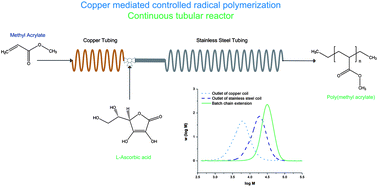Single electron transfer-living radical polymerization (SET-LRP) has been recently proposed as a “variant” of the originally-developed atom transfer radical polymerization (ATRP). There has been very little research done, however, combining SET-LRP with reducing agents. In this view, Cunningham and co-workers reported an innovative design for a flow reactor for the continuous production of uniform polymer with high livingness using SET-LRP, improving upon the initial concept. Instead of using copper tubing to construct the entire reactor, a short copper coil was used to initiate polymerization and generate soluble copper species. The bulk of the reaction then took place in inert stainless steel tubing, using ascorbic acid as a reducing agent to drive the catalytic cycle and mediate the polymerization. Polymerizations were conducted at ambient temperature with 30 wt% DMSO as solvent, producing well defined living polymer at a steady state conversion of 78% for a residence time of 62 min. Chain extensions using outlet polymer solutions were well-controlled and proceeded to high conversion in a short period of time, with a final concentration of 10 ppm of residual copper. The results illustrate the significant potential of using a continuous tubular reactor with ascorbic acid as a reducing agent as an efficient means to scale-up production of well controlled polyacrylics and other multiblock copolymers.
Copper mediated controlled radical polymerization of methyl acrylate in the presence of ascorbic acid in a continuous tubular reactor by Nicky Chan, Michael F. Cunningham and Robin A. Hutchinson Polym. Chem., 2012, 3, 1322-1333.
To keep up-to-date with all the latest research, sign up for the journal’s e-alerts or RSS feeds or follow Polymer Chemistryon Twitter or Facebook.











